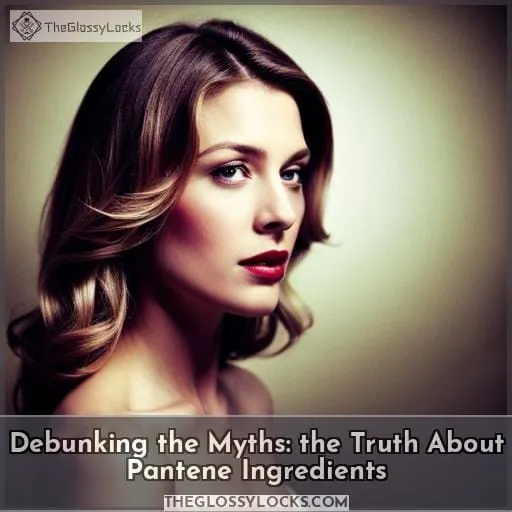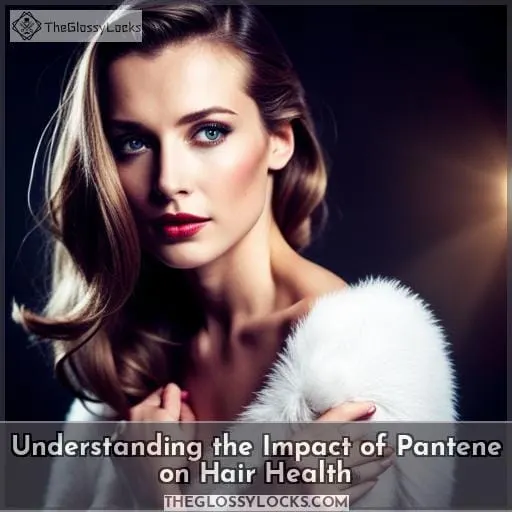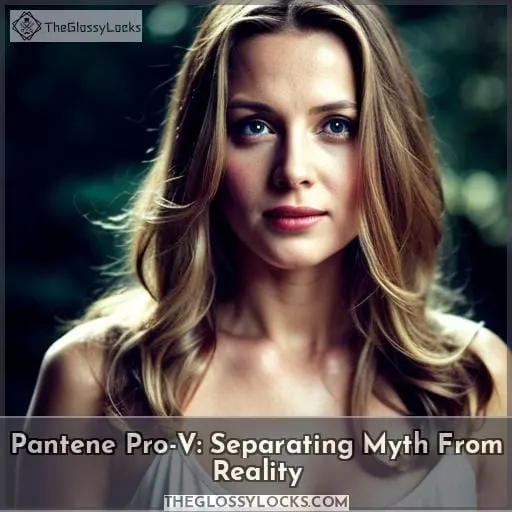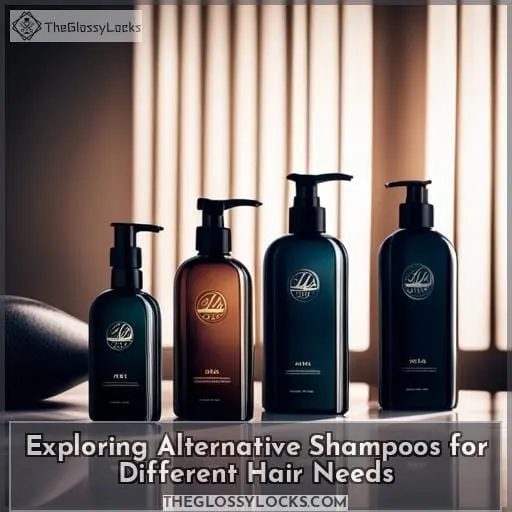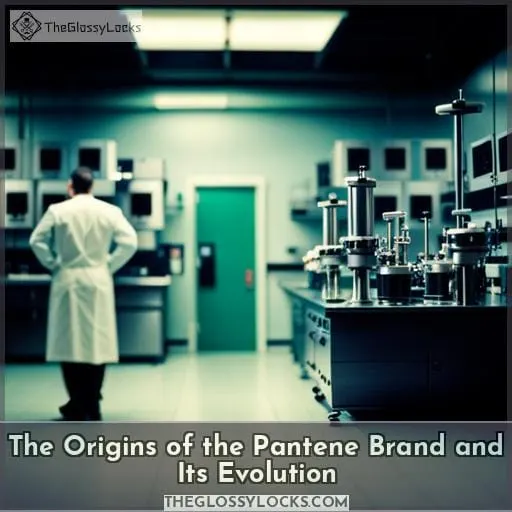This site is supported by our readers. We may earn a commission, at no cost to you, if you purchase through links.
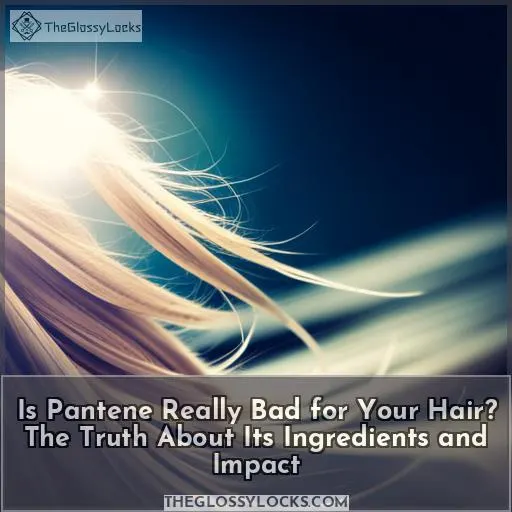 Do you feel like Pantene is bad for your hair? You’re not alone. In recent years, rumors have made their rounds online that the popular shampoo and conditioner are damaging to hair health due to its ingredients.
Do you feel like Pantene is bad for your hair? You’re not alone. In recent years, rumors have made their rounds online that the popular shampoo and conditioner are damaging to hair health due to its ingredients.
We’ve looked into the facts about Pantene’s ingredients and impact on your tresses, so you can separate myth from reality when it comes to caring for your locks with this classic brand.
Table Of Contents
- Key Takeaways
- Debunking the Myths: the Truth About Pantene Ingredients
- Understanding the Impact of Pantene on Hair Health
- Pantene Pro-V: Separating Myth From Reality
- Exploring Alternative Shampoos for Different Hair Needs
- The Origins of the Pantene Brand and Its Evolution
- The Role of Science and Transparency in Pantene’s Response
- Conclusion
Key Takeaways
- Pantene has faced rumors about being bad for hair due to ingredients like sulfates, silicones, and formaldehyde donors.
- Pantene offers sulfate-free products for those concerned about sulfates in shampoo.
- Pantene provides tailored solutions for different hair types and needs.
- Pantene engages with customers through open dialogue and provides scientific reasoning.
Debunking the Myths: the Truth About Pantene Ingredients
Pantene is a well-known drugstore hair care brand containing ingredients such as sulfates, silicones, and formaldehyde donors. While skeptics may say that these compounds can be harmful to your hair, it’s important to understand the truth behind Pantene’s ingredients in order to make an informed decision about using them.
Sulfates in Pantene Shampoo
You may have heard that Pantene shampoo contains sulfates, which can strip the natural oils from your hair and scalp. But don’t be too quick to judge – Pantene also offers a range of sulfate-free products for those looking for an alternative.
The effects of using sulfates on hair depend on how often they are used, as well as other factors like water hardness and product pH levels. To maintain moisture balance in your hair, it is important to cleanse with gentle cleansers or use clarifying shampoos every now and then.
Sulfate-free options offer gentler cleansing benefits without sacrificing effectiveness; try out various formulas until you find the one that works best for you!
Silicones in Pantene Conditioner
Silicones in Pantene conditioner can make hair smooth but may lead to buildup. To reduce this risk, try using a clarifying shampoo every few weeks for deep cleaning and avoiding products with high levels of silicones.
For detangling, use a wide-tooth comb or your fingers instead of brushes that can snag delicate strands and cause breakage.
Haircare misconceptions abound – be sure to read labels carefully before trying new products! Consider product alternatives like sulfate-free shampoos for an extra gentle cleanse free from harsh chemicals like sodium lauryl sulfates found in some Pantene products.
With the right haircare routine, you’ll avoid potential damage caused by silicone buildup while still enjoying softness and texture without compromising on quality haircare needs; no matter what your individual hair type is!
Formaldehyde Donors in Pantene
Formaldehyde donors, widely used in Pantene products, can potentially dry out your hair and cause irritation. This ingredient is controversial due to possible allergic reactions and sensitivities to its presence in hair care products.
However, the levels of formaldehyde found are within industry safety standards set by regulatory agencies worldwide.
Haircare controversies such as this one often arise from unsubstantiated claims about haircare brands like Pantene. These claims must be carefully assessed with scientific reasoning for accuracy before drawing conclusions about product safety or effectiveness.
While individual experiences vary based on factors such as budget and hair type, ultimately it is up to the consumer to decide what works best for them when choosing a haircare brand like Pantene.
Pantene offers both sulfate-free and silicone-free options alongside more traditional formulas containing formaldehyde donors.
Understanding the Impact of Pantene on Hair Health
When it comes to hair health, Pantene has a targeted approach that aims to provide solutions for different needs. With products specifically designed for curly African hair, human wigs, and gray hair, the Gold Series Argan Oil Shampoo & Conditioner is sulfate-free and paraben-free with added Argan Oil to gently cleanse while restoring resilience and flexibility back into your locks.
Pantene’s Targeted Approach for Different Hair Needs
With its tailored products, Pantene provides targeted solutions for different hair types and needs. Their formulations are designed to be compatible with various hair textures, offering customized options like sulfate-free shampoo or silicone-free conditioner.
The brand also highlights the benefits of their ingredients in product descriptions to illustrate the impact on scalp health and nourishment.
Testing out the effectiveness of these products can help individuals find what works best for them. Whether it’s a classic formula or one specifically formulated for curly African Hair, customers can trust Pantene as they make an informed choice when selecting haircare items that meet their personal needs in today’s ever-changing haircare market.
Pantene Pro-V: Separating Myth From Reality
With the growing public concern over Pantene’s potential hair damage, it is crucial to distinguish between myth and reality. This article will examine the impact of Pantene on hair health and highlight important factors to consider when selecting products from this well-known brand.
Hair Loss Concerns and Individual Sensitivities
When it comes to hair loss concerns, individual sensitivities can play a role in how Pantene products affect you. Hair loss triggers may include hormonal changes, stress levels, and genetics—all of which require custom care and attention.
Sensitivity factors such as scalp health need to be taken into consideration when deciding on the best haircare routine for your needs. Alternatives like sulfate-free shampoos or silicone-free conditioners should be considered if you have a sensitive scalp or allergies that could lead to adverse reactions from Pantene’s ingredients.
Ultimately, choosing the right product for your hair type depends on understanding what works with your body’s chemistry and assessing current lifestyle habits accordingly.
Addressing Dandruff and Color Stripping Claims
If you’re worried about dandruff and color stripping, Pantene’s Gold Series Argan Oil Shampoo and Conditioner are a great choice. They are formulated with gentle cleansing ingredients like argan oil, which helps restore resilience to dry or damaged hair without causing buildup.
The paraben-free formula of these products makes them ideal for scalp health maintenance, as parabens can potentially cause dryness or irritation.
For those looking to preserve their hair color while avoiding harsh chemicals in haircare products, this set is an excellent option. It does not strip away natural oils from the scalp that protect against discoloration caused by environmental factors.
To improve your overall hair health and reduce the impact of any potential damage from coloring processes over time, consider using hydrating masks every few weeks.
Exploring Alternative Shampoos for Different Hair Needs
Discovering the right shampoo depends on your specific hair needs, so explore alternative options to find what works best for you. With a diverse selection of haircare solutions out there, it’s important to customize your routine according to your hair type.
A quick look at Pantene’s brand offerings can help determine which product is best suited for you. From sulfate-free shampoos and conditioners to tailored products designed specifically for curly African or gray hair, Pantene offers a wide range of choices that cater towards different types of tresses.
Additionally, lighter versions are available if the original formula causes buildup in certain areas due to its heavier ingredients like silicones and parabens. These ingredients may potentially dry out strands when used too frequently or heavily applied onto the scalp and roots.
The Origins of the Pantene Brand and Its Evolution
You may be familiar with the long-standing Pantene brand and its evolution since 1945. What began as a single product has grown into an extensive collection of hair care solutions, revolutionizing the industry with innovative ingredients and scientific rationale.
Pantene’s beginnings in Europe as a conditioning cream created by Swiss scientists set it apart from other brands on the market, becoming one of the first to offer conditioning ingredients known for their moisturizing benefits.
From there, Pantene rapidly grew in popularity both domestically and abroad before eventually being acquired by Procter & Gamble (P&G) in 1985—ushering even more growth within today’s competitive hair care market.
This transformation has resulted in dedicated collections tailored to various needs such as breakage repair or heat protection while also introducing sulfate-free formulas for those seeking gentler alternatives free from harsh chemicals like sodium lauryl sulfate (SLS).
With over 70 years of dedication towards perfecting their products’ performance backed up by scientific research, it’s no wonder why millions continue to trust this iconic brand when caring for their locks!
The Role of Science and Transparency in Pantene’s Response
As Pantene continues to be a popular brand, it is important to understand the role of science and transparency in its response. By engaging with customers through open dialogue and providing scientific reasoning behind its ingredients, Procter & Gamble (P&G), which owns Pantene, differentiates itself from smaller companies making unsupported claims.
With this approach, P&G seeks to ensure that individuals can make informed decisions about products best suited for their hair needs.
Scientific Reasoning Behind Pantene Ingredients
Unraveling Pantene’s ingredients and the reasoning behind them can be a complex task – so why not get to the bottom of it with science?
Surfactants, like sodium laureth sulfate found in Pantene Pro-V shampoos, help break down dirt on hair shafts.
Parabens are used as preservatives and have been linked to dryness but don’t necessarily lead to irritation or damage.
Silicones add smoothness but could also cause build-up over time if too heavy for your hair type.
Solid scientific research supports these claims, providing further evidence on how safe their products really are for use by consumers everywhere.
Hair health insights into chemical composition reveal that there is no real reason why using Pantene should be bad for your hair – just find what works best!
Open Dialogue and Customer Engagement
By engaging with customers in an open dialogue, Pantene has demonstrated their commitment to scientific reasoning and transparency. P&G’s approach to customer engagement includes providing answers to beauty rumors, hair care tips from stylists, product comparisons by ingredients and price points, as well as self-serving press releases.
This helps to provide a balanced view of the brand while showing that they are aware of consumer concerns regarding potential damage caused by its products.
Conclusion
Exploring the truth about Pantene, it’s time to assess if the brand is really bad for your hair.
Despite the myths, Pantene does not contain wax or plastic, and the ingredients it does use are not inherently harmful. However, sulfates, silicones, and parabens can strip natural oils, make hair smooth, and dry hair, respectively.
As such, Pantene’s impact on hair health depends on individual needs and sensitivities. Pantene Pro-V is tailored to different hair types and budgets, and alternative shampoos are available for those with specific needs.
Ultimately, whether Pantene is right for you and your hair is a personal decision.

